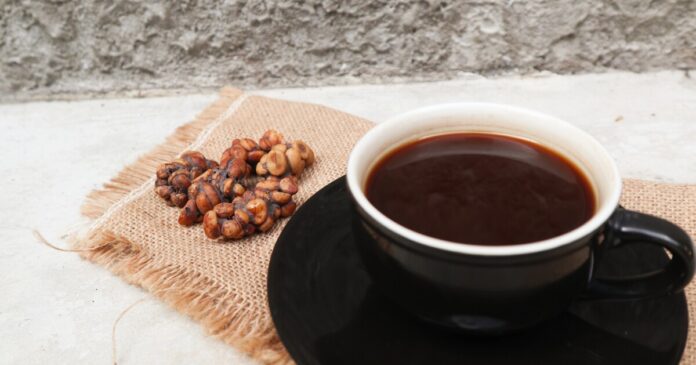If you brew your own espresso, you’ll know this about coffee: it’s easy to make a very dull drink from great beans. Just by letting them stale, for example.
If you’ve been served expresso by an expert roaster from a scrupulously clean high-end machine, you’ll also know this: it’s hard to imagine that a coffee drink could be better.
And yet there’s a strong market for kopi luwak, a drink made from beans that sell for 10 times the price of alternative coffees, or more. So strong, in fact, that recent research on what makes it so special estimated that global revenue would reach US$11 billion by 2032, which would assign to it 3% of the projected world coffee market.
The “luwak” in kopi luwak is the Asian palm civet, a small mammal that looks like a ferret but is more often said to resemble a cat. The beverage renowned as the world’s most expensive is brewed from beans that the animal has excreted. It digests the flesh of the raw coffee berry but discards the interior seed – the bean – with its scat.
What’s so special about beans extracted from civet poo has long been debated. There’s a theory that the civet has a nose for the best berries, so that the beans it excretes are the cream of a crop. However, it’s not clear how the berries a civet thinks best must enclose seeds that a human will treasure, given that the two species covet different parts of the fruit.
The second theory – which does not exclude the first – is that something happens to the bean as it passes through the civet that makes brewed beans taste especially delicious. This is the theory tested by research published late last month in the journal Scientific Reports, under the title “Civet Robusta and natural Robusta coffee are different on key fatty acid methyl esters and total fat”.
As the title suggests, the researchers analyzed coffee beans they had retrieved from wild civet scat, and compared them with undigested beans they had harvested from the plantations where the scat was picked up. They found that total fat was significantly higher in the scat-sourced raw beans, as were two fatty acid methyl esters. And the civet-poo beans were bigger on average, a finding attributed to civets choosing the most fleshy berries.
That the civet-poo beans were richer in fatty compounds was significant because fat, as the authors say, “contributes significantly to coffee’s aroma and taste profile.”
The two enhanced fatty acid methyl esters, caprylic and capric, “are instrumental as flavoring and aroma agents in food,” the authors observed, “often imparting a dairy or milk-like aroma and flavor. … Both compounds are traditionally used as flavoring agents in certain dairy-based products and as antimicrobial agents.”
The researchers emphasized that the beans they tested were raw. They did not take the further step, for example, of having coffee experts roast beans from the two sources and comment on any divergence in flavor. “Therefore, variations in fatty acid content in raw beans should be interpreted cautiously and not directly equated with differences in the flavor of the final roasted coffee,” they said.
Nevertheless the identification of differences in digested and non-digested beans implies that something is going on in the 12-36 hours that a bean may spend inside a civet. Drawing on prior research, the authors propose that: “Passing through the digestive system of the civet is a type of natural fermentation that increases the complexity of the flavor.”
So there, the exotic and costly beans really are different. But does that justify their high price?
Kopi luwak production is associated most strongly with parts of Indonesia, and the growing demand for it internationally has led to producers there farming caged civets that they feed mainly coffee beans. Obviously the caging makes redundant any special properties of selection that wild civets possess.
Just as obviously, it’s a lot easier to collect scat from caged civets than to forage for it, so most kopi luwak now comes from caged animals. Animal protection organization PETA has highlighted the poor conditions in which many farmed civets are held, and alleges that much of their product is sold fraudulently as wild-sourced. It recommends that coffee enthusiasts avoid the novelty drink altogether.

The study cited here was conducted not in Indonesia but in the Western Ghats ranges of India, at Kodagu, where entrepreneurs have begun to produce civet coffee, allegedly from wild animals. The research implies that even Asian palm civets found in India can modify coffee, and references Indian media quoting the entrepreneurs as saying that they could supply kopi luwak locally for much less than the international price.
Even if costs fell to the level of the best undigested Arabicas, I wouldn’t be rushing out to try civet coffee.
It is said that the challenge when brewing coffee is to produce a drink that tastes as good as fresh coffee smells. It is easy to imagine that the burgeoning interest in kopi luwak is founded not just on its cute story, but also on dissatisfaction with coffee made from natural beans. Even in Melbourne, one of the world’s coffee centers, cafes that make memorable drinks are exceptions.
Anyone might blame their disappointment on the beans, and hope for a better experience from beans incubated by civets. But freshness, roasting, grinding, brewing and cleanliness account for most of what separates a great coffee from one you’d rather spit out. That will be true too of all kopi luwak, whichever method is used to prepare it.
Source: Scientific Reports


